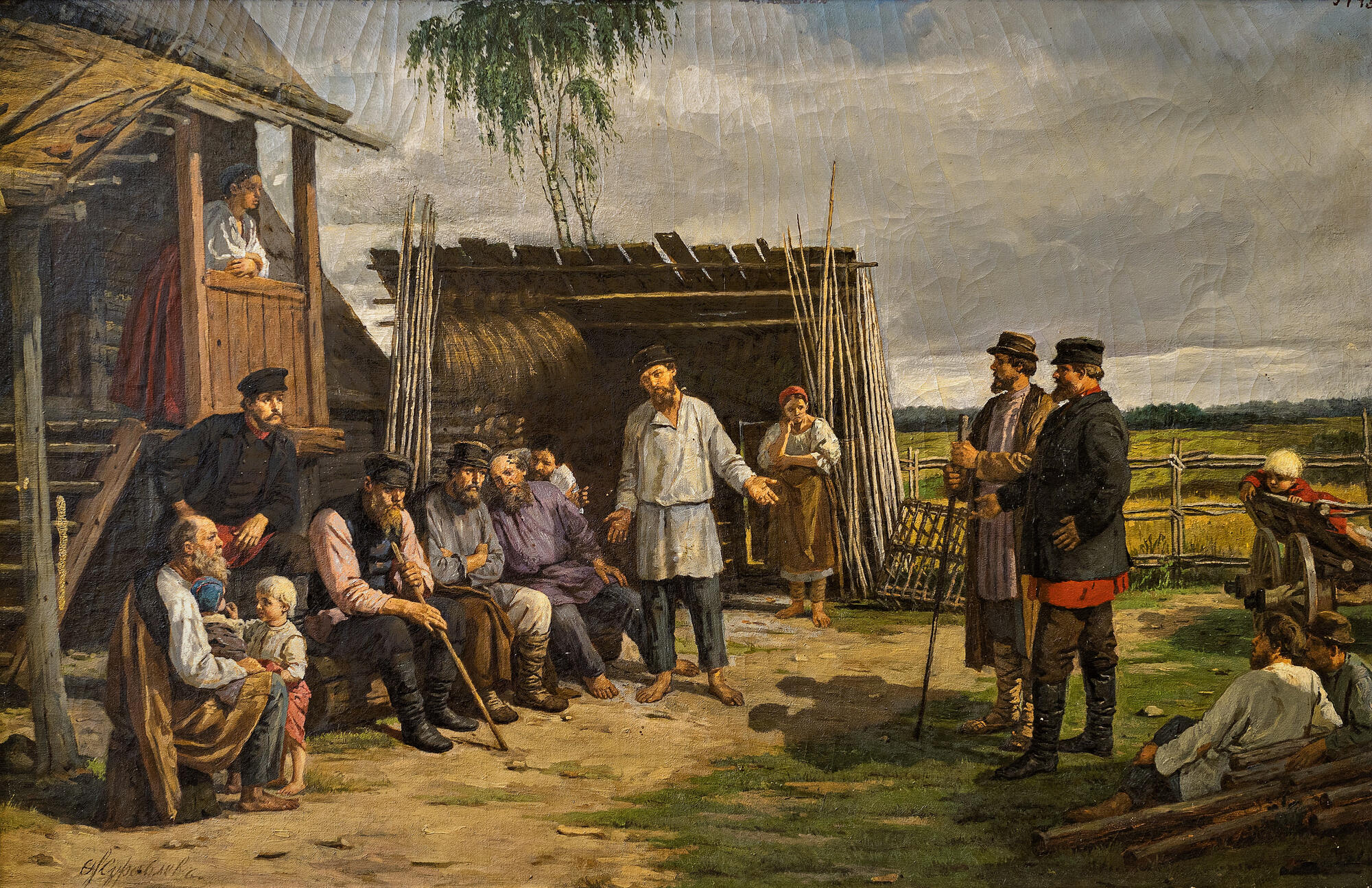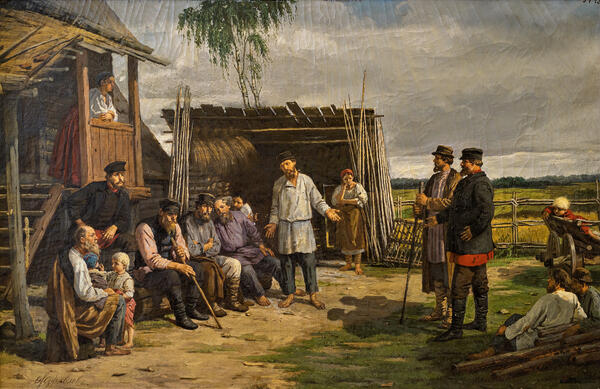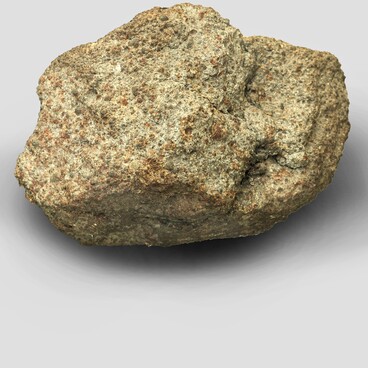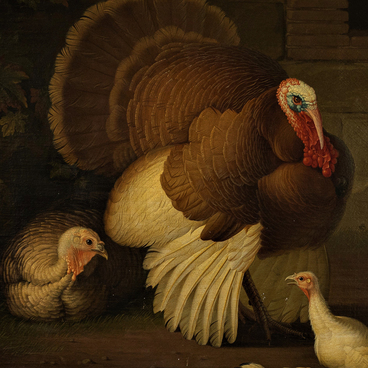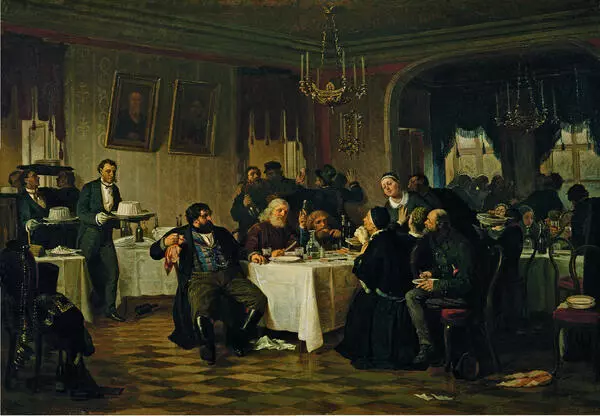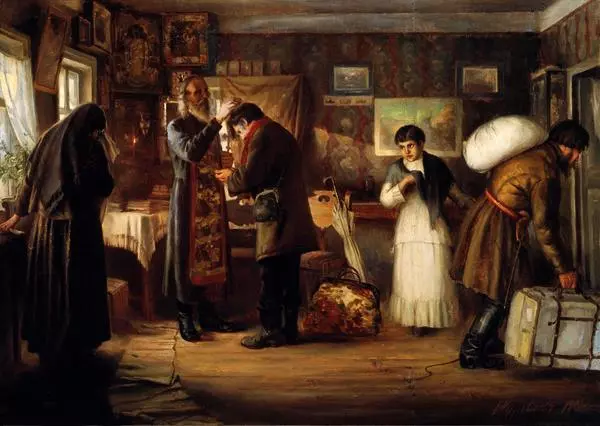The genre painting “Peasants” Gathering’ from the collection of the Volsk Museum was painted by artist Firs Zhuravlev in 1873. It is dedicated to the clash between the poor peasants and the prosperous village headman.
The characters of the painting are participating in a rural gathering, which was the self-government of Russian peasants in the second half of the 19th — early 20th centuries. The gatherings were convened as needed. Urgent problems were solved there: village headman was chosen, the land was divided, issues of either buying or selling the land were decided, zemstvo (organ of rural self-government in the Russian Empire) and state taxes were distributed. From time to time, family disputes were resolved and those who were guilty of something were excluded from the community.
On the canvas, the artist contrasted two powerful figures of well-dressed men and a clear dark shadow they cast toward the quiet peasants. The headman and his helper convince the gathered people. The peasants frown and keep silent. In the center of the scene, a barefoot peasant stands and throws up his hands. After analyzing the poses and facial expressions of the participants of the gathering, the museum experts have suggested that Firs Zhuravlev depicted a gathering at which the increase in exactions was being discussed, the requirements of which the peasants could hardly fulfill.
Firs Zhuravlev was born in Saratov on December 10, 1836, in the petty-bourgeois family. His father was a tailor and wanted his son to continue his business. Therefore, until the age of nineteen, Firs Zhuravlev was engaged in tailoring, but in 1855, he went to St. Petersburg to enter the Imperial Academy of Arts.
Initially, the young artist attended the academy as an external student and then became a regular student of the historical painting class. In 1858, Firs Zhuravlev received his first small silver medal and was awarded a small gold medal of the Academy for the painting ‘The Creditor Describes the Widow’s Property’ in 1862. During his studies, he became friends with artist Ivan Kramskoi.
In 1863, Firs Zhuravlev, together with Ivan Kramskoi and twelve other artists, refused to compete for the Big Gold Medal and applied to leave the Academy. This event was called the Revolt of the Fourteen: the best artists of the Academy did not participate in the competition when the authorities refused their request to do a painting on a free topic and thereby equalize historical and genre artists.
The artists who left the Academy had to vacate their workshops, causing some to lose their homes. Then the rebels organized the St. Petersburg Artel of Artists, an independent organization of artists, whose goals were mutual assistance and search for earnings. In 1870–1871, the Artel gradually declined due to disagreements. Many participants joined the Association of Traveling Art Exhibitions (Peredvizhniki). In 1888–1889, Firs Zhuravlev presented his works at traveling exhibitions but did not join the association.
Firs Zhuravlev was mainly engaged in genre painting. His paintings on the topic of everyday life (“Return from the Ball” and “Merchant”s Funeral Banquet”), as well as nude paintings (“Girls in the Bathhouse” and “Naked Woman”), which were rare for the Russian art of that time, were popular.
The characters of the painting are participating in a rural gathering, which was the self-government of Russian peasants in the second half of the 19th — early 20th centuries. The gatherings were convened as needed. Urgent problems were solved there: village headman was chosen, the land was divided, issues of either buying or selling the land were decided, zemstvo (organ of rural self-government in the Russian Empire) and state taxes were distributed. From time to time, family disputes were resolved and those who were guilty of something were excluded from the community.
On the canvas, the artist contrasted two powerful figures of well-dressed men and a clear dark shadow they cast toward the quiet peasants. The headman and his helper convince the gathered people. The peasants frown and keep silent. In the center of the scene, a barefoot peasant stands and throws up his hands. After analyzing the poses and facial expressions of the participants of the gathering, the museum experts have suggested that Firs Zhuravlev depicted a gathering at which the increase in exactions was being discussed, the requirements of which the peasants could hardly fulfill.
Firs Zhuravlev was born in Saratov on December 10, 1836, in the petty-bourgeois family. His father was a tailor and wanted his son to continue his business. Therefore, until the age of nineteen, Firs Zhuravlev was engaged in tailoring, but in 1855, he went to St. Petersburg to enter the Imperial Academy of Arts.
Initially, the young artist attended the academy as an external student and then became a regular student of the historical painting class. In 1858, Firs Zhuravlev received his first small silver medal and was awarded a small gold medal of the Academy for the painting ‘The Creditor Describes the Widow’s Property’ in 1862. During his studies, he became friends with artist Ivan Kramskoi.
In 1863, Firs Zhuravlev, together with Ivan Kramskoi and twelve other artists, refused to compete for the Big Gold Medal and applied to leave the Academy. This event was called the Revolt of the Fourteen: the best artists of the Academy did not participate in the competition when the authorities refused their request to do a painting on a free topic and thereby equalize historical and genre artists.
The artists who left the Academy had to vacate their workshops, causing some to lose their homes. Then the rebels organized the St. Petersburg Artel of Artists, an independent organization of artists, whose goals were mutual assistance and search for earnings. In 1870–1871, the Artel gradually declined due to disagreements. Many participants joined the Association of Traveling Art Exhibitions (Peredvizhniki). In 1888–1889, Firs Zhuravlev presented his works at traveling exhibitions but did not join the association.
Firs Zhuravlev was mainly engaged in genre painting. His paintings on the topic of everyday life (“Return from the Ball” and “Merchant”s Funeral Banquet”), as well as nude paintings (“Girls in the Bathhouse” and “Naked Woman”), which were rare for the Russian art of that time, were popular.
